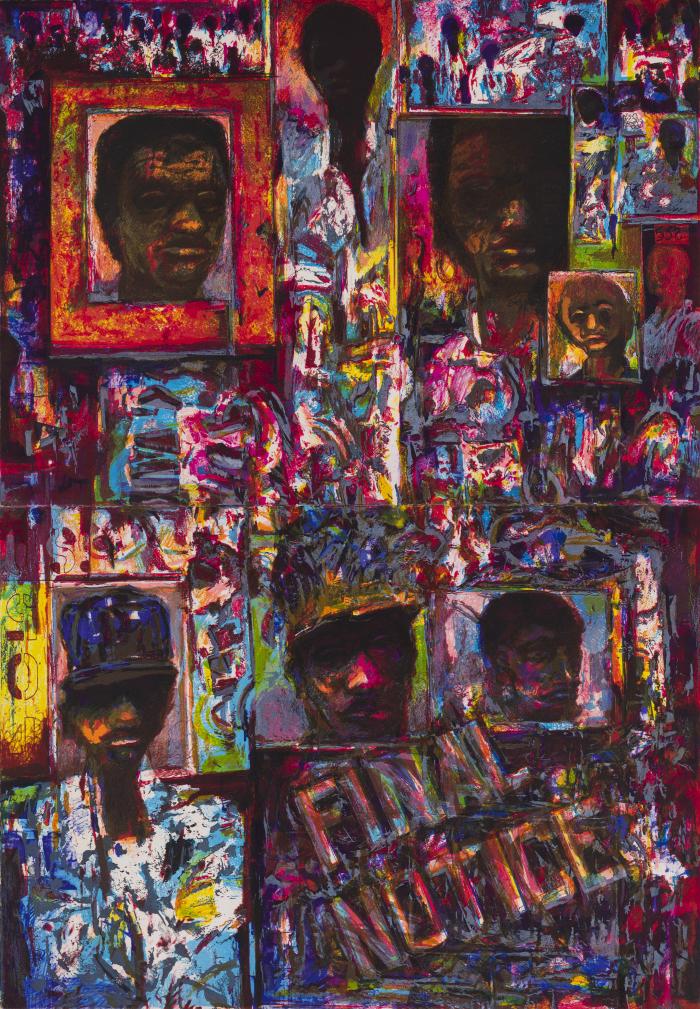
Generations
Paul Keene
- 1996
- Offset Lithograph
- Image/sheet: 43 x 30"
- 100 prints in this edition
About the Print
From the Artist
Generations offers viewers a set of windows in which men—churchmen, fathers, grandparents, and children—are connected in the extended family that is bound together by past struggles, common backgrounds, and the persistent hope that the future will be better. The phrase “Final Notice” is not to signify an end of past hardship, but to proclaim and offer a challenge for a new beginning that will break old cycles.
—From Brandywine Workshop and Archives records
Speculation is the only way possible for me to indicate why I follow one direction or another. Happenings on paper or canvas are predictable up to a critical point for me. Beyond this, intuition and instinct take over. I only know that any verbal statement can only give vague clues as to why I pursue a certain direction in working and thinking. For me the subject matter simply becomes a vehicle used to help discover the mystery. Then the idea becomes the mystery that must be made real; it is the means by which I render some of what I assume I know with the unknown. I hang on and take the wild ride.
—From Brandywine Workshop and Archives records
My style is how I see things, how they filter through you. I paint intuitively. I can’t plot and plan…it’s all in my head and it depends upon the color and then I get a big idea of what I’m supposed to do and then I try to do it. If painting your art makes any sense, then it has to come out, and sometimes you wish it to come out with much more enthusiasm or from much more excitement than it does, but you have to be proud. After a certain point, it’s putting this together, and you just plot and scrape away…you either throw it away or it leads you to a new idea. So, you start a new canvas, or you take all of that out, but one little place that works, then you start again.
—From https://www.youtube.com/watch?v=Oz72bw0kOoo, accessed 6-25-2021
Generations, 1996, is Keene’s most complex Brandywine print, an offset lithograph in an edition of 100. It is made up of two sheets that are joined together to form one large print that measures 30 x 43 inches. Each sheet includes 14 color separations created on mylar with ink and Stabilo pencil. This print is considerable because it documents a significant collaboration between Keene and Brandywine. Over the course of three months, he created 28 drawings. Robert Franklin, the printer, pushed the printing process as far as he could to preserve some of Keene’s signature painterly qualities. Generations appears hand-painted and retains a mysterious and dark quality that was a transitional element in Keene’s aesthetic at the time. The print is connected to Keene’s “Urban Wall Series,” a body of work in which the artist reflects on his childhood in North Philadelphia in the 1930s and 1940s. While the images in that series depict the deterioration of homes and family structures in what was once a middle-class mixed community, they also highlight the unseen wealth of spirit, cultural richness, and human assets that will eventually change the community for the better. Generations provides us with a series of windows through which people—churchmen, fathers, mothers, grandparents, neighbors, and children—are linked in an extended family bound together by past struggles and the persistent hope that their children’s future will be brighter.
— Adapted from Bruce Katsiff, https://bucksco.michenerartmuseum.org/artists/paul-f-keene, accessed 6-25-2021, Brandywine Workshop and Archives records and “Fresh, Human and Personal: Signature of Brandywine Workshop,” Three Decades of American Printmaking: The Brandywine Workshop Collection (Manchester, VT: Hudson Hills Press, 2004)

Paul Keene
American
Born August 24, 1920 in Philadelphia, PA
Died
November 26, 2009 in Warrington, PA
About the Artist
Philadelphia-born painter, printmaker, and muralist Paul F. Keene, Jr. received a BFA, BS, and MFA from Temple University. He also studied at the Academie Julian in Paris, France. There he helped found Gallerie 8, a collective gallery for American artists working in Paris. After teaching at the Philadelphia College of Art, he went on to help establish the art department at Bucks County Community College, where he retired as Professor Emeritus. Keene’s works can be found around the world in several institutions including the Philadelphia Museum of Art, the African American Museum in Philadelphia, the Pennsylvania Academy of the Fine Arts, James A. Michener Art Museum in Pennsylvania, the British Museum in London, the Nigerian National Museum, the Dallas Museum of Art, Tucson Museum of Art in Arizona, and the Woodmere Art Museum in Philadelphia, Pennsylvania. He lived and practiced his art in Warrington, Pennsylvania until his death.
—From Brandywine Workshop and Archives records
Curriculum Connections
Suggested Topics for Expressive Writing
Expressive Writing
The writings of Haki R. Madhubuti reflect a similar way of stereotyping as the word-prints of Edgar Heap of Birds. People of African descent are disproportionately represented in entertainment—as dancers and singers, particularly—and in professional sports. They are perceived as physically strong and fast. In American society, Blacks may entertain, play sports — or cook and clean. Outside of those realms, however, Blacks both with and without advanced education, social prominence, and financial success are considered dangerous, therefore representing a threatening presence at both ends of the socioeconomic spectrum.
Our abilities as viewers to understand the messages and connections that the artists hope their imagery will convey is largely based on the extent of our own experiences and information that we bring to viewing and interpreting the artwork. In many countries, these types of messages are not brought to broad public attention and are often considered subversive.
Questions to Consider
- Why are some people considered a threat while others are not?
- Why is there education inequality in most developed countries?
- Who benefits from stereotyping others?
Related Media
- “America Calling” by Haki R. Madhubuti (Don L. Lee)
- “AWARENESS” by Haki R. Madhubuti (Don L. Lee)
- “Middle Passage” by Robert Hayden
- Amistad (1997 film) directed by Steven Spielberg
- Just Mercy (2019 film) directed and written by Destin Daniel Cretton
- King in the Wilderness (2018 documentary) directed by Peter W. Kunhardt
- Committed to Memory: The Art of the Slave Ship Icon by Cheryl Finley, PhD (2018)